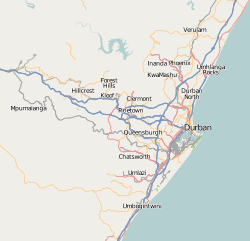Hillcrest, KwaZulu-Natal
| Hillcrest | |
|---|---|
 Hillcrest  Hillcrest  Hillcrest
| |
|
Location within Durban  Hillcrest | |
| Coordinates: 29°46′48″S 30°45′46″E / 29.78000°S 30.76278°ECoordinates: 29°46′48″S 30°45′46″E / 29.78000°S 30.76278°E | |
| Country | South Africa |
| Province | KwaZulu-Natal |
| Municipality | eThekwini |
| Established | 22 January 1895 |
| Government | |
| • Ward Councillor | Rick Crouch[1][2][3] (Democratic Alliance) |
| Area[4] | |
| • Total | 21.44 km2 (8.28 sq mi) |
| Population (2011)[4] | |
| • Total | 13,329 |
| • Density | 620/km2 (1,600/sq mi) |
| Racial makeup (2011)[4] | |
| • Black African | 11.4% |
| • Coloured | 0.8% |
| • Indian/Asian | 3.0% |
| • White | 84.3% |
| • Other | 0.6% |
| First languages (2011)[4] | |
| • English | 82.7% |
| • Afrikaans | 7.6% |
| • Zulu | 6.9% |
| • Other | 2.9% |
| Postal code (street) | 3650 |
| PO box | 5119 |
Hillcrest is a settlement within eThekwini in KwaZulu-Natal, South Africa and forms a part of the Upper Highway Area.
History
Hillcrest was formerly a sleepy village, governed by its own Town Board [5] on the outskirts of Durban that has now become a booming suburb incorporated into the eThekwini Metropolitan Municipality. Hill Crest (as the town's name was variously spelt until 1969) was founded on a rise in the main road from Durban to Pietermaritzburg in 1895 as a farming or "weekend" village, then a good distance from what was the emerging port of Port Natal. The village was laid out as leasehold sites on a portion of the farm Albinia owned by William Gillitt, one of the main pioneer families of the area and after which the nearby suburb of Gillitts is named.
One of the other early families to set up in the area was the Acutts who had already established the well known in Durban estate agents firm of that name. In 1903 the first school in the village was established in a wood and iron cottage in Hospital Road leased to a Mrs McMillian, the principal of the first Highbury School, by Horace Acutt.
When the first Hillcrest Health Committee was established in 1943, the total all-race population was 1135 persons and only the Main Road was hardened. Nkutu Road was hardened with klinker in 1947 and this was followed in 1951 with the hardening of the first portion of Inanda Road. In 1962 blacktopping of selected roads in the central area began, followed by further roads in 1965. By 1971, when Town Board status was obtained, the total population had grown to 2799 persons.
The Hillcrest Waste Water Treatment Plant was finally established in the 1990s, then serving only the central commercial area of the village with phased extensions planned in time, with other areas continuing on septic tanks.
The town celebrated its centenary in 1995 and has since then seen an incredible increase in inhabitants migrating from more central areas in Durban
Hillcrest Today
Hillcrest lost its independent Town Board status in 1996 and was made subject to administration by the Outer West Local Council - a substructure council of the then Durban Unicity. In 2000, the Outer West Local Council, along with other local councils, was disestablished and were replaced by the single eThekwini Municipality encompasing the entire Durban metropolitan area.
The suburb of Hillcrest experienced a building boom in the late 1990s and 2000s with the construction of many gated communities and shopping centres.[6]
Schools
A public school system is provided in Hillcrest including Hillcrest High School and Hillcrest Primary School,[7][8] with Winston Park Primary School in nearby Winston Park.
Private schools include Highbury Preparatory School and Hillcrest Christian Academy with Kearsney College and the Roseway Waldorf School in nearby Botha's Hill and Alverstone respectively.
Famous residents
- Dale Benkenstein, Nashua Dolphins cricket player
- Wayne Fyvie, former Sharks and SA national rugby player
- Ian McIntosh, former Rhodesian, Sharks and SA national rugby coach
- Shaun Pollock, former Dolphins and SA national cricket player and captain
- Terence Parkin, Olympic medalist
- Heather Hamilton, Miss South Africa 1999,[9] Miss Universe top 10 1999, Miss World contestant 2000
- Megan Coleman, Miss South Africa 2006, Miss Universe 2007, Miss World contestant 2007
- Harold 'Tiger' Wright, South African Champion Jockey
- Sir Liege Hulletts, Founder Kearsney College, founder Hullett's sugar
References
- ↑ Councillor ready to tackle problems hands-on
- ↑ Independent Electoral Commission - 2011 Election Results
- ↑ Ward 10 - Official Ward 10 Councillor Web Site
- 1 2 3 4 "Main Place Hillcrest". Census 2011.
- ↑
- ↑ Mullany, David (2007). "Hillcrest of a wave". The Property Magazine.
- ↑ "Hillcrest Primary School Website". HCPS. Retrieved 23 October 2014.
- ↑ "KZN primary school gets top marks for technology adoption". www.itweb.co.za. IT Web. 14 November 2012. Retrieved 5 November 2014.
- ↑ "Heather Hamilton: Who's Who SA". Who's Who SA.
- ↑ Tongaat Hulletts history
Sources
- Lest We Forget - The Story of Hillcrest 1895 - 1995, Elizabeth Camp, c. 1996
- Hillcrest Gillitts Activity Corridor Local Development Plan - Outer West Local Council, 2000
- The Highway Mail, 1 June 2011.
- The Hilltop, 2 June 2011.
- Independent Electoral Commission (South Africa), 9 June 2011.
.svg.png)